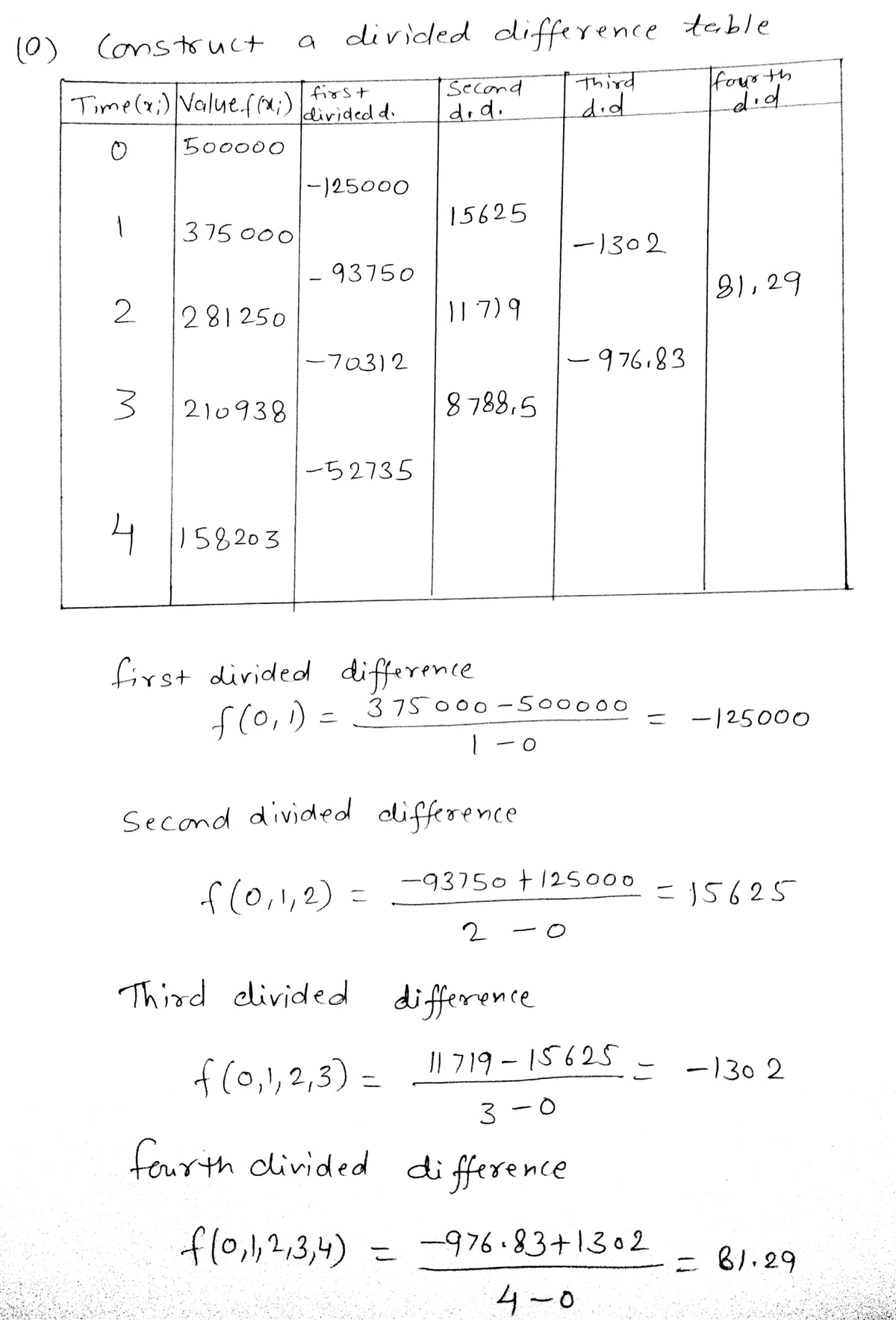Time (x₁) 0 Value 500 000 (y-f(x)) 1 2 3 375 000 281 250 210 938 4 158 203 depicts the value (in Rands) of an automobile at intervals of 1 year over a period of 4 years. Here i=0,1,2,...,4 while the quantities xo = 0 and yo = 500 000, respectively, represent the time of purchase and purchase price of the automobile. a) Construct a divided difference table for the above data. b) Use the table presented in Part a), along with Newton's divided difference formula, to approximate f(2.5) with a polynomial of degree 3, P3(x). Use xo = 0 as the starting node of the polynomial.
Time (x₁) 0 Value 500 000 (y-f(x)) 1 2 3 375 000 281 250 210 938 4 158 203 depicts the value (in Rands) of an automobile at intervals of 1 year over a period of 4 years. Here i=0,1,2,...,4 while the quantities xo = 0 and yo = 500 000, respectively, represent the time of purchase and purchase price of the automobile. a) Construct a divided difference table for the above data. b) Use the table presented in Part a), along with Newton's divided difference formula, to approximate f(2.5) with a polynomial of degree 3, P3(x). Use xo = 0 as the starting node of the polynomial.
Advanced Engineering Mathematics
10th Edition
ISBN:9780470458365
Author:Erwin Kreyszig
Publisher:Erwin Kreyszig
Chapter2: Second-order Linear Odes
Section: Chapter Questions
Problem 1RQ
Related questions
Question
Apply 2 decimal places rounding where applicable

Transcribed Image Text:Time
(x₁)
Value
(y₁ = f(xi))
0
500 000
1
2
281 250
375 000
3
210 938
4
158 203
depicts the value (in Rands) of an automobile at intervals of 1 year over a period of 4
years. Here i= 0,1,2,...,4 while the quantities xo = 0 and yo = 500 000, respectively, represent the
time of purchase and purchase price of the automobile.
a) Construct a divided difference table for the above data.
b) Use the table presented in Part a), along with Newton's divided difference formula, to
approximate f(2.5) with a polynomial of degree 3, P3(x). Use xo = 0 as the starting node of the
polynomial.
c) Estimate the error in the approximation in Part b).
ENG
Expert Solution
Step 1
Since there are multipart, therefore here solutions of part (a) and (b).

Step by step
Solved in 2 steps with 2 images

Recommended textbooks for you

Advanced Engineering Mathematics
Advanced Math
ISBN:
9780470458365
Author:
Erwin Kreyszig
Publisher:
Wiley, John & Sons, Incorporated

Numerical Methods for Engineers
Advanced Math
ISBN:
9780073397924
Author:
Steven C. Chapra Dr., Raymond P. Canale
Publisher:
McGraw-Hill Education

Introductory Mathematics for Engineering Applicat…
Advanced Math
ISBN:
9781118141809
Author:
Nathan Klingbeil
Publisher:
WILEY

Advanced Engineering Mathematics
Advanced Math
ISBN:
9780470458365
Author:
Erwin Kreyszig
Publisher:
Wiley, John & Sons, Incorporated

Numerical Methods for Engineers
Advanced Math
ISBN:
9780073397924
Author:
Steven C. Chapra Dr., Raymond P. Canale
Publisher:
McGraw-Hill Education

Introductory Mathematics for Engineering Applicat…
Advanced Math
ISBN:
9781118141809
Author:
Nathan Klingbeil
Publisher:
WILEY

Mathematics For Machine Technology
Advanced Math
ISBN:
9781337798310
Author:
Peterson, John.
Publisher:
Cengage Learning,

